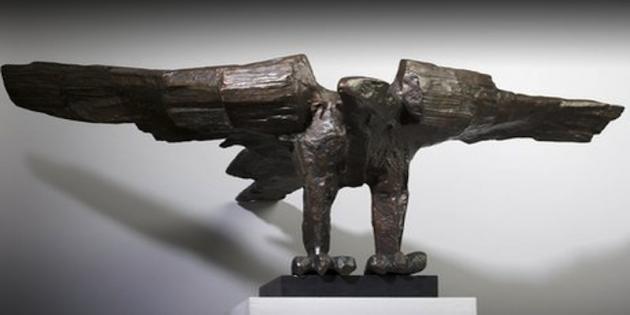A retrospective exhibition of the work of Dame Elisabeth Frink, a leading sculptor in post-war Britain is being mounted at the Lightbox in Woking Surrey. . Frink is renowned worldwide for her figurative work, she conveys emotion, vulnerability and aggression through her powerful artworks, which continue to generate debate. The exhibition, the first retrospective of Frink’s work for over 25 years, largely consists of work from the Ingram Collection of Modern British Art, with additional loans coming from the Elisabeth Frink estate.
Elisabeth Frink was brought up in rural Suffolk, near to an active airbase, where as a child she experienced the machine gun attack of a German fighter plane. Warfare and seeing filmed reports of concentration camps had a powerful impact on Frink, who later became an active supporter of Amnesty International. he conflicting horror and heroism of war, the dead hand of political oppression, compassion and spiritual strength are themes to which she frequently returned.
Frink had early and continued artistic success and made mainly figurative sculptures, particularly of male and animal subjects. She was more concerned with representing mankind than with portraits of individuals. In her obituary, Bryan Robertson wrote that ‘the images of a single naked male figure, standing, walking or running, say something about endurance, vulnerability and essential human nature that haunts the memory’.
This display of sculptures includes a series of three Riace bronzes inspired by the ancient Greek warrior statues discovered off the coast of Riace, Italy, in 1972. Frink felt that ‘the original figures were very beautiful, but also very sinister… these were warriors who would go out and fight your battles for you, mercenaries… in other words they were thugs’.
The painted faces on these and Sitting Man II are inspired by Frink’s interest in Aboriginal art that developed after a visit to Australia. She uses the idea of a mask as ‘a way of showing that their beauty in a sense hides what they are up to’. Running Man is tall, lithe and naked. Frink said ‘my Running Men are not athletes: they are vulnerable, they are running away from something, or towards it’. The display also includes standing male figures which in turn convey strength and defiance, disorientation and fallibility.
Frink lived in Britain and France, before settling in Dorset. Her experience of different landscapes made her increasingly enthusiastic about her sculpture being shown in the open air and she was an early supporter of YSP. An open air retrospective of her work was shown here in 1983 and a memorial exhibition during 1993.
Photo: Courtesy Lightbox
The Lightbox Woking Surrey 19 February — 21 April, Main and Upper Gallery Free Entry, donations welcome

